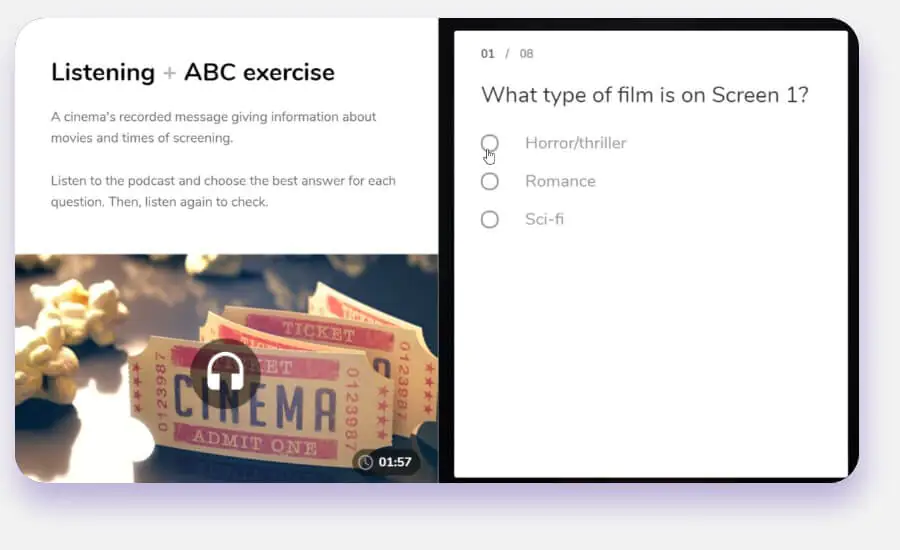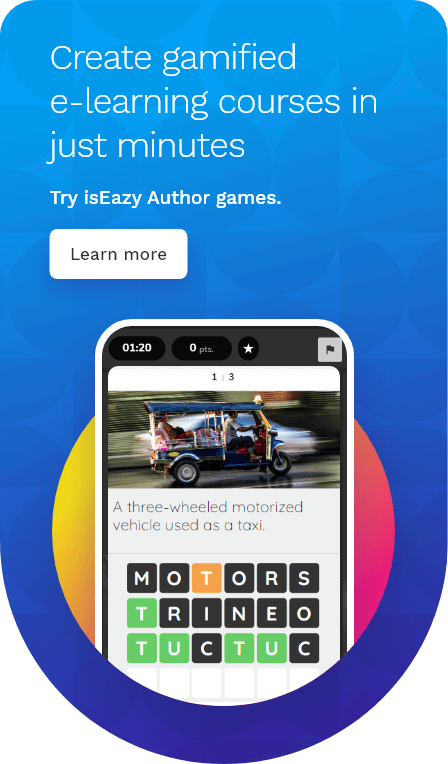Table of contents
ToggleThanks to digitalization and the emergence of new technologies, the way in which training is delivered has evolved dramatically in recent times. As a result, it is now possible to carry out a wide array of training activities that allow you to maximize the results you get.
These activities can take place in-person or through e-learning. To give you a chance to get to know them all, we’ve decided to bring you this list of the best and most essential training activities for the new workforce. So keep reading, and discover everything you need to know!
Why are training activities so vital to success?
In order to understand their importance, we first need to grasp what training activities are. Put simply, they are a set of actions – such as reading, answering, repeating, or performing exercises like matching and selecting – which allow students to acquire knowledge.
These activities promote the uptake of knowledge in different ways. Some of them explain real-life phenomena or help to solve problems, while others encourage students to reproduce knowledge they have already acquired. In either case, they are vital resources for stimulating the understanding and assimilation of key concepts.
Naturally, they play a crucial role in the success of training, since they serve to motivate students, encourage active participation, and help them to retain information more effectively – three aspects which are the foundation of more meaningful and deeper learning.
The benefits of implementing training activities in your company
When well-designed and intentionally geared towards achieving business objectives, implementing activities in staff training can be key to success for any organization. Some of their most important benefits include:
- Heightening employee engagement
Engaging employees in learning activities increases their level of motivation by offering them a sense of achievement and tangible progress. This, in turn, deepens their commitment to the learning process – and to the company in general.
- Promoting better knowledge retention and skill development
Some of the best training activities allow employees to blend theoretical understanding with practical experience, two key elements for skill development and knowledge retention. Through exercises, games, simulations and questionnaires, employees have the chance to put their learning into practice, facilitating its later application in the work environment.
- Reducing training time
In general, staff training activities accelerate the learning process. There are two main reasons for this. First, such activities allow employees to ‘learn by doing’, and also provide them with immediate feedback that helps them identify areas for improvement. Both factors, especially in combination, greatly reduce the time needed for training.
- Ensuring an alignment with business objectives
By designing training activities that focus on specific company goals and objectives, you can ensure that your corporate training program directly contributes to organizational success.
Different types of activities for staff training
The effectiveness of training depends not only on the content you include, but also on the methodology you employ. Below, we present a list of the best training activities, in order to help you offer stimulating, interactive and effective training in both face-to-face and online settings:
Face-to-face training activities
In-person training is, of course, the most traditional method of teaching. This is the model we’ve been familiar with for many years, and it brings both advantages and disadvantages. Its advantages for students include close proximity to the instructor, and the opportunity for immediate responses when discussing learning. On the other hand, its disadvantages include geographical limitations (some students may not be able to get to the place of learning), as well as the impossibility of reviewing classes through recordings.
Face-to-face training is still a key part of many companies’ strategies, and is also of particular importance for hybrid workforces, so it’s important to use engaging employee training activities that promote collaboration, sharing and discussion wherever possible. This becomes easier to achieve when employees are invited to participate actively. Let’s take a look at some of the ways this can be done:
1. Instructor-led activities
These are the most classic and recognizable activities in face-to-face training. They include verbal explanations, feature support materials such as videos or PowerPoint, and are instructor-focused. Today, these employee training activities can also be led by virtual instructors, or make use of e-learning technology to switch the focus onto the employee.
2. Role Playing Games
One good way to enhance participation and learning efficiency is to create activities based on storytelling. What does this mean? Design a story that connects students to the central concept you wish to communicate.
This strategy becomes even more interesting when you attempt to apply the storytelling element to a real-life environment, and you can do this through role-playing games.
For example, you might provide customer service training, offering tools and strategies to deal with real-life situations such as complaints, refund requests, and dissatisfied customers. A role-playing game that recreates these types of situations provides employees with a safe and controlled environment in which to practice. They can take this opportunity to learn how to manage such situations in the workplace, while simultaneously receiving feedback from an instructor on how to better deal with them.
3. Debates
Discussions during training help employees to learn more naturally. This activity usually forms part of a social learning strategy within a company. This strategy is based on the theory that observation, interaction and collaboration with other people can cause an individual to learn new behaviors or skills.
Featuring debates as a training activity will allow valuable ideas, thoughts or questions to emerge from students. This is best achieved by involving an instructor, who should present the topic for debate and guide the group through specific questions intended to spark controversy. The key here is to encourage employee participation as much as possible so that students learn to analyze, prioritize, question, and argue.
4. Tutoring
Mentoring is a highly valuable employee training activity. It can allow a new or less experienced employee to feel more comfortable within the company, and encourage them to ask questions that they may be hesitant to share directly with a supervisor.
Mentoring works by pairing an experienced employee with a newer one who requires help, and is especially useful during the onboarding process. Such relationships provide a good level of training, and are also beneficial for building connections within the labor force.
5. Games or group dynamics
Games and group dynamics are excellent training activities for employees, not only because they are engaging, but also because they improve collaboration and cohesion. When coupled with scores or rewards, they automatically lead to higher engagement and learning retention.
One effective dynamic is to group employees into teams that then need to compete to solve a simple task or even develop a project. Each team will need agreement among its members if they wish to succeed, and this will allow a natural debate to develop, thereby improving their teamwork skills.
The key factor to remember with game-based learning is that it must be implemented with a specific purpose in mind, and also used in moderation in order to obtain good results.
E-learning training activities
E-learning offers all the advantages of face-to-face training, but also transforms learning into a more flexible and effective process. It does this by eliminating barriers such as long distance and inconvenient schedules, as well as adding dynamic and interactive elements that engage students.
This type of training is also highly accessible, adapting to the individual needs of each employee and targeting the skills they need for the future of work, such as critical thinking or problem solving.
Creating e-learning courses to train your employees with precision is very easy with an authoring tool. These tools allow you to easily integrate interactive elements, creating reinforcement activities to improve the results of your training. Below, we share some of the best online training activities:
1. Simulations
Simulations, like role-playing games, provide a safe space in which employees can learn how to manage situations that may be difficult, uncomfortable, or simply new to them. What distinguishes simulations from role-playing games is that simulations are much more specific and unfold in a more rigid manner. During their development process, an interconnected network of branching scenarios is created that allows dialogue to be produced automatically in a virtual space.
For example, dialogue simulations created with linked scenes allow you to create a series of screens, through which an employee can interact with a customer and, depending on their responses, be directed to one of several possible different scenarios. These training activities are perfect for creating learning maps, putting theoretical concepts into practice, and motivating employees to improve themselves.
2. Micro videos or mini training tutorials
Microlearning is a powerful ally in employee training, and although it is a complete learning strategy in itself, you can include isolated elements of it in your courses, such as interactive micro videos or short tutorials
Video content, when provided in small doses, helps employees to find quick and easy answers, while tutorials help them to refresh or learn new skills quickly and efficiently. In addition, both help students to avoid cognitive overload, improve their knowledge retention, and are also accessible at any time or place, making them perfect to integrate into your training activities.
3. Exercises and Games
Exercises are a valuable tool that allow you to test what has been learned during training, and are also useful for acquiring skills in the first place. Games alter the nature of training by converting tasks into fun challenges that capture student attention, while simultaneously teaching them to make decisions, use their initiative, enhance creative thinking and solve problems.
4. Questionnaires, quizzes or evaluations
In both face-to-face learning and e-learning, questionnaires, quizzes and evaluations are key strategic elements that offer feedback to both employees and companies. The difference between the two is that in face-to-face training, the instructor is generally in charge of correcting and distributing feedback to each student, while in e-learning it is possible to carry out these processes automatically through a platform, as well as record student progress.
Do you want to learn more about all the different types of assessments you can use in your e-learning courses? Discover the answers in this article.
5. Webinars
More and more companies are making use of webinars to train their employees, and this is hardly surprising. Webinars are efficient, save costs, and participants can access them whenever they wish (plus review the recordings).
These days, however, most people are not satisfied with simply listening to a person speaking for an hour. The keys to an attractive webinar are therefore good content (rich in support materials such as videos, slides or animations), the possibility to listen to multiple speakers or experts and, most importantly, the use of interactive features such as surveys and live chats.
How to plan and design effective training activities
Now you know what employee training activities you can implement within your organization, it’s time to start planning and designing them. To do this, it’s essential to take into account a range of factors that will guarantee their effectiveness and relevance:
- Establish clear learning objectives: Before getting started with designing any activity, clearly define the objectives you want to achieve with it. These must be specific, measurable, achievable and relevant.
- Know your audience: Understanding the needs, preferences and learning styles of your team will help you structure and adapt training activities more effectively.
- Select the best methodology: Choose the learning methodology that best suits your objectives and needs. You can choose between gamification, collaborative learning, microlearning, mobile learning and many more.
- Always keep attractiveness and variety in mind: The idea here is to create activities that are interesting, interactive and varied, that manage to keep the attention and commitment of participants throughout the training process.
- Integrate technology effectively: If you’re designing online training activities, be sure to take advantage of all the technological tools at your disposal to improve your team’s learning experience.
Strategies to develop impactful training activities
The following strategies can help you to develop employee training activities that have a positive impact on your team’s learning:
- Contextualize learning
A good way to make learning more meaningful and relevant is to relate training activities to real-life situations and challenges that your team faces on a daily basis.
- Promote collaborative learning and participation
Design activities that involve employee participation, such as group discussions, hands-on exercises, problem solving, or role-playing. This will naturally encourage collaboration between team members.
- Include gamification elements
Use gamification techniques, along with elements such as rewards, leaderboards or rankings, to make training a more fun and motivating process.
- Provide constructive feedback
During or after each activity, you can offer constructive feedback to help employees identify areas for improvement and reinforce weak points.
Tips for adapting training activities to the needs of your team
Finally, in order to ensure the effectiveness of training activities, you should take care to adapt them to the specific needs of your team. Several strategies are open to you:
- Conduct a needs assessment
Identifying areas for improvement and the specific training needs of individuals is vital if you want activities to benefit your team. Be sure to conduct a thorough evaluation to locate any priority development areas. You can use tools such as isEazy LMS to identify training needs across all roles within your organization.
- Customize content
Adjust the content of your training activities to make it relevant and applicable to the specific requirements of your team and company. Create opportunities to apply this knowledge, so employees can practice what they learn in real-life situations.
- Be flexible
When it comes to online training, it’s important to offer flexibility so that employees can decide when and where to access learning.
Create e-learning courses packed with amazing activities, thanks to isEazy Author
So, are you ready to provide the best learning experience for your employees? Now you can do it with isEazy Author, the cloud-based authoring tool that allows you to create intuitive e-learning courses in just a few minutes.
isEazy Author brings you a wide array of ready-to-use interactives such as games, linked scenes and exercises, perfect for creating high-impact training activities for your employees.
















